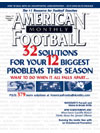AMERICAN FOOTBALL MONTHLY THE #1 RESOURCE FOR FOOTBALL COACHES
Article CategoriesAFM Magazine
|
Challenging the Placekickby: Mike CabaHead Football Coach, Alfred State College (NY) © More from this issue During my thirty-five years on the sidelines I've watched in amazement as teams would not contest the PAT kick of their opponents. The defensive players might wave their arms to distract the kicker, maybe a rusher would come off the edge and a couple of players might jump up in an effort to block a kick but usually a PAT kick attempt would go unchallenged. Often, even where there was a poor or slow snap, a bobbled hold, or a slow kicker, the kick would cross the bar and the extra point would go on the board. This was always frustrating to me and I started seeking ways to challenge our opponents’ placekick. As most coaches do, each year we look for something that we can effectively add to our preparation that takes minimal practice time but might make a difference in the outcome of a game, if executed properly. ....The full article can only be seen by subscribers. Subscribe today!
|
|
|||||||
| HOME |
MAGAZINE |
SUBSCRIBE | ONLINE COLUMNISTS | COACHING VIDEOS |
Copyright 2025, AmericanFootballMonthly.com
All Rights Reserved





